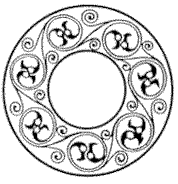
|
|
The Celtic Englishes |
The Celtic Englishes I - Reviews |
Hildegard L.C. Tristram, ed., The Celtic Englishes, Anglistische Forschungen, 247 (Heidelberg: C. Winter, 1997), xii + 441 pp., DM 88.00
Andreas Fahrmeir: (Research on British History in the Federal Republic of Germany, 1995-1997, London: German Historical Institute London, 1998, S. 14.)
This book contains papers read at a conference organized by the University of Potsdam in September 1995, and devoted to the variations of English spoken in the "Celtic" countries of Wales, Scotland, Ireland, and Newfoundland and Labrador. Many of the papers are detailed linguistic analyses of the local versions of the English language spoken there, which - to the eye of the layman, at least - seem to bear out Manfred Görlach's opening remarks that there is no such thing as a single Celtic English, but which will be of little interest to historians, except for those who take the 'linguistic turn' very seriously indeed. However, a number of papers - Gwenllian Awbery on Wales, Philip Payton on Cornwall, C.I. Macafee and Colm Ó Baoill on Scotland, and Graham Shorrocks on Newfoundland and Labrador - relate the evolution of language and the rise of English in their areas to social, political, and economic developments, and thus throw a different, if not always new, light on the history of the Celtic Fringe.
Edgar C. Polomé: (The Journal of Indo-European Studies, 1998: 26, 3/4 , p. 508).
The impact of Celtic on the English of the areas where Celtic has died out or decayed has been a neglected subject; therefore, the authors of this impressive collection of papers concentrate on the fate of Celtic and its influence on English in Ireland, Wales, Cornwall, the isle of Man, and Scotland, as well as the areas of Canada with heavy Scotch and Irish immigration. The papers take us from the clash of phonological systems in Northern Ireland to Gaelic and Cape Breton English. The impressive socio-linguistic compendium is accompanied by a bibliography, notes on the authors and an index of personal names. The book is the outcome of a colloquium organized on the topic at the University of Potsdam in 1995. The objective was to study the grammar and lexicon of the relevant dialects and to illuminate Celtic-English linguistic contacts in their socio-cultural context. Positive evidence for linguistic features of purely Celtic origin remains elusive, but some of these characteristic traits have been identified by the contributors, making this colloquium worthwhile in the investigation of Celto-English contact vernaculars and mutual impact.
... A detailed analysis of possible influences of Scottish Gaelic on Scots is found in C. I. Macafee and C. Ó Baoill, 'Why Scots is not a Celtic English', Tristram, Celtic Englishes, 245-86. R. D. Clement, 'Highland English', ib., 301-07, is a looser study noting that 'Highland English ... partakes of some of the phonetic features of Gaelic'. B. Bird, 'Past and present studies of Hebridean English phonology', ib., 287-300, summarizes the work of others, especially Cynthia Shuken, in this field, noting some proposed Gaelic influences including preaspiration (non-phonemic) in Barra English (noted as not noticed by Borgstrřm). In J. Shaw, 'Gaelic and Cape Breton English', ib., 308-19, attention is also drawn to the feature of preaspiration in the English speech of Inverness County, which is among a list of Gaelic influencews, some tentative, proposed for this little researched area. Also in the New World, G. Shorrocks, 'Celtic influences on the English of Newfoundland and Labrador', ib., 320-61, has an interesting section reviewing the small extent of Scottish Gaelic settlement, dating back to the 1840s, mostly via Cape Breton, in the Codroy Valley of Newfoundland, noting scope for further research on Gaelic influence on English there. G. Broderick, 'Manx English: an overview', ib., 123-34, gives a broad account of the phonology of Manx English but also lists lexical borrowings and syntactic influences from Manx Gaelic. ...
This volume sees the publications of 14 papers delivered at a colloquium at the Institut für Anglistik und Amerikanistik at the University of Potsdam. The editor, Professor Tristram, has provided a fine introduction to the scope and aims of the book (pp.1-26), while Manfred Görlach (27-54) has examined the broad question 'Celtic Englishes'. The varieties of English spoken in Wales, Cornwall, Scotland, the Isle of Man and Ireland have been dealt with, as have those of Cape Breton and Newfoundland and Labrador.
The papers directly relating to Ireland are J.M. Kirk, 'Ulster English: The State of the Art' (135-79; R. Ó hÚrdail 'Hiberno-English: Historical Background and Synchronic Features and Variation' (180-200); J. Harris 'Phonological Systems in Collision in the North of Ireland' (201-224); and Markku Filppula 'The Grammar of the Irish Dialects of English: Some Problems and Controversies' (225-44). The book contains a most useful bibliography (pp. 367-427) and is a welcome addition to the field of language contact.
Copyright © Successor (last update: 12.09.1999 -
Successor@GMX.NET)